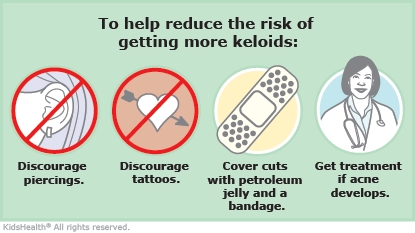Keloid: How to Care for Your Child
A keloid (KEE-loyd) is a growth that can happen when the skin is injured. It looks like a raised scar and is larger than the original wound. A keloid keeps growing even after the wound is healed. Some can feel sore or itchy. Keloids are harmless, but some kids are bothered by how they look.




Who gets keloids? Keloids are more common in people 10 to 30 years old and in those with dark skin. They can run in families. If someone has had a keloid, anything that can cause a scar may lead to another.
Keloids can form after acne, burns, chickenpox, bug bites, piercings, tattoos, surgery, scratches, or cuts. They're most often found on the ears, neck, jaw, shoulders, chest, and upper back.
Can keloids be prevented? To help prevent keloids:
-
Avoid piercings and tattoos.
-
Keep cuts moist while healing. Put a thin layer of petroleum jelly on cuts and cover them with gauze or a bandage. Change regularly to keep the gauze or bandage clean and dry.
-
Get treatment for acne.
-
Avoid unnecessary surgeries.
If your child needs surgery in the future, tell the surgeon ahead of time that your child gets keloids.
Can keloids be treated? A keloid usually stops growing within about a year. It doesn't need treatment unless it is painful or your child doesn't like how it looks.
Available treatments include injections, cryotherapy (freezing the keloid using a special tool in the doctor's office), laser treatments, medicine that is put on the keloid, and pressure bandages. Sometimes more than one treatment is used. Keloids can come back after treatment.